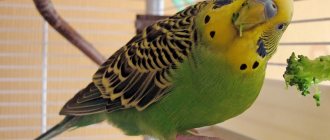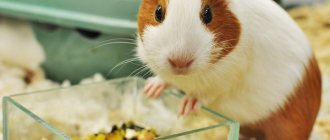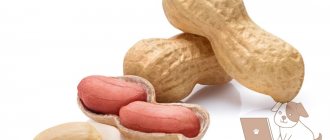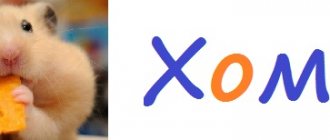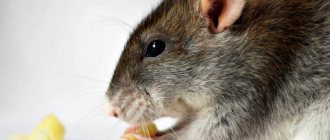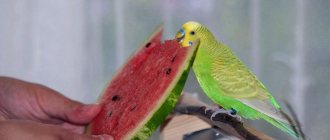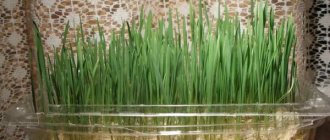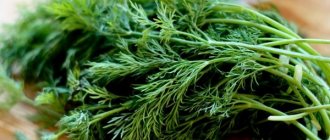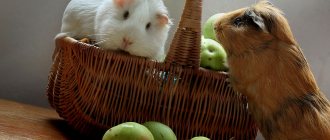Sometimes owners doubt which fruits can be given to parrots and which should be discarded. Birds living in their natural environment instinctively distinguish edible fruits from poisonous ones. You should not deprive your feathered pet of tasty and healthy treats - they are necessary for health. You can pamper your parrot with bright, sweet delicacies and reward him for good behavior.
What fruits can parrots eat?
Parrots can and should be fed fruits: they are rich in vitamins, sugars, fiber, and microelements. The list of permitted fruits is impressive; it contains most types of fruit crops. It is permissible to include in your daily diet:
- apples;
- pears;
- peaches;
- apricots;
- dates;
- grape;
- kiwi.
Feel free to give pears to parrots and apples grown in local orchards. The peel contains concentrated nutrients, so it is not advisable to cut it off. Beautiful imported apples are also allowed, but the wax should be thoroughly washed off with hot water.
Pineapple is high in vitamins, but this fruit is not on the table very often, but only on occasion. You can occasionally treat your pet to a ripe piece. Watermelons and melons are harmless only in August and September. There is no need to remove small bones - birds love to crack them open. There is no reason to wonder whether a parrot can have an orange. Citrus fruits are a storehouse of vitamin C. Birds readily peck at the white subcortex and partitions, and do not disdain the juicy pulp.
You shouldn't take risks by offering papaya and mango to your bird. These fruits are picked unripe to extend their shelf life. They contain substances harmful to birds. But pomegranate is good for the intestines: if a feathered pet pecks at the peel, it will not have inflammatory processes.
Attention! Regarding persimmons, so adored by parrots, one thing can be said: they are not prohibited, but only in a ripe state. If persimmon leaves an astringent aftertaste, it means it contains a lot of tannin, a compound with tannic properties. It can cause digestive upset in birds.
Prohibited Products
Parrots, like all pets, should never be given food from the table. Dangerous products can not only harm the health of the bird, but also kill it.
The following are subject to special prohibition:
- Fried food. A large amount of oil and fat will cause serious digestive disorders for the parrot.
- Spices and seasonings, hot pepper, salt, sugar.
- Alcohol.
- Sausages.
- Spicy aromatic plants. Greens such as cilantro, sorrel, celery, dill and parsley are harmful.
- Meat and fish. Parrots are not carnivores, so these foods should not be included in their diet.
- Bread and other yeast products, due to the dangerous influence of yeast. Crackers are also prohibited.
- Sweets. Candies, marmalade, marshmallows are harmful to parrots.
- Branches of oak, poplar, bird cherry, lilac, maple, acacia.
- Cheese and butter, cream, milk.
- Some vegetables. Harmful to birds: radishes, eggplant, potatoes, garlic, onions, celery.
- Some fruits and berries. Dangerous to bird health: mango, avocado, persimmon, papaya, bird cherry. Fruit seed kernels should not be given to birds. Candied fruits are also prohibited.
- Finishing elements. Parrots should not be allowed to feast on wallpaper, plaster, polystyrene or foam materials. The high content of toxic chemicals in them can kill your pet.
Never feed birds by mouth, as human saliva contains many microorganisms that are dangerous to them.
Parrots should not be allowed to eat most houseplants, as they are often poisonous:
- bulbous - amaryllis, clivia, lily;
- blooming - adenium, azalea, anthurium, cyclamen, oleander, nightshade, hydrangea;
- decorative leaves - aglaonema, croton, monstera, ivy, ficus, poinsettia.
A balanced, nutritious diet for parrots is the basis for their activity and good health. Contact of birds with dangerous and harmful products should be avoided so as not to harm the pet.
You can learn about proper nutrition for parrots in the video:
The parrot does not want to eat fruit: what is the reason
Parrots are curious, but they are afraid of new things. If the bird has never seen or tasted the fruit, it will be difficult to convince it to eat. No matter what form you offer the appetizing fruits, the bird simply ignores the treat. Also, not all fruits are readily eaten by a parrot when it is sick.
Birds in pet stores and on the market are most often kept in an economy mode: cheap food is used, the cage is rarely cleaned, and several birds live in crowded conditions. Constant stress causes a feeling of fear and wariness in birds. They are afraid to try something new, and they get used to a simple grain mixture.
Methods for solving the problem
The most difficult thing is to teach wavy animals to eat fruits. If a budgie does not eat fruit for a long time, it is recommended to enrich its diet with vitamin complexes or a grain vitamin mixture. Larger bird species eagerly eat all fresh and dried fruits offered.
The demonstration method works well when the owner shows visually and emotionally that the food is very tasty. You can put a piece of pear on the cage or between the bars and pretend that it is very tasty. The owner's affectionate voice and demonstration of eating often encourages the bird to come up and try. Until the parrot learns to eat on its own, its diet should be enriched with vitamin complexes. Among these, a liquid composition added to the drinker has a good effect. Care and patience are all that is necessary for a bird to learn to eat fruits.
How to teach a parrot to eat fruit
When the chick is actively interested in everything around him, you need to start feeding him fruit. But what if you bought an adult with character? A wayward pet may stubbornly refuse succulent feeding, and this will have a bad effect on its health.
Like picky children, birds need to be introduced to new food gradually, patiently, unobtrusively. Experiment, act outside the box, be creative. There are many ways to outwit a cautious pet:
- Peel a ripe banana for your parrot, press grains from dry food into the pulp and place it between the bars of the cage. When pulling out familiar food with its beak, the pet will involuntarily try a banana.
- Chop or grate fruits, puree them, or squeeze out juice. Make fruit salads. Different shapes, textures and colors of food can attract birds.
- Mix small particles of fruit into the main feed. There is a chance that your ward will grab a new product along with the grain. Of course, such a mixture cannot be left in the feeder for a long time, otherwise it will spoil.
- Take the fruit holders, hang them and place them inside the cage. A parrot may mistake fruit kebabs on skewers for a toy. Perhaps, while playing, he will swallow a piece and taste it.
- Pour boiling water over dried apricots, prunes, dry apples, and figs. The bird may not like raw fruits, but it will love dried ones. Just not candied fruits - they contain a lot of sugar.
Worth a try! Demonstratively, gnawing on a juicy pear, apple, and peach with gusto. An inquisitive bird will want to know what the owner is eating that is so delicious, it will try to peck at a piece.
One of the easiest methods to introduce a bird to eating fruit is to organize collective feeding. In a single cage space, being close to its neighbors, the parrot will try to grab food before everyone else. It's okay if the cereal and juice fly all over the place. Some portion of the treat will still end up in the stomach.
What not to give
The birds are very happy with the various treats that their owners give them. The diet can be quite extensive, but there are still a number of fruits that should never be given to your pet.
The consequences can be very diverse.
Persimmon
When consuming this fruit, there is a high probability that your pet will develop problems with the gastrointestinal tract. It is not a toxic fruit, but it is better to protect yourself and your pet. If there is a strong desire to feed a bird with persimmons, you need to give it an absolutely fresh product, having first peeled it.
Avocado
The main disadvantage of avocado is the presence of a large persin. It is extremely toxic and its consumption can lead to the death of the bird. For this reason, it is better to exclude avocados from your diet.
Mango
This is a very popular fruit that birds eat in the wild. It is rich in various vitamins, contains a lot of fiber and various salts. However, it is not recommended to give it to your pet as a treat, otherwise there is a high risk of various diseases due to the presence of a huge amount of essential oils and tannins in the composition.
Papaya
Like all exotic fruits, it can be dangerous to the health of your budgie.
The point is a large number of different essential oils and tannins. They can have a negative effect not only on the functioning of the digestive tract, but on health in general.
Berries for the parrot
Parrots can eat not only fruits - they love to feast on berries. Make sure you always have fresh, dried or frozen fruits in stock:
- Rowan;
- currant;
- irga;
- rose hip;
- honeysuckle;
- raspberries;
- gooseberry;
- chokeberry.
At the beginning of summer comes the season of fragrant strawberries. It contains vitamin C and antioxidants, so its benefits are undeniable. The answer to the question whether a parrot can eat strawberries is only positive if the amount of nitrates does not exceed the norm.
The gifts of the swamp are tasty and healthy: cranberries, lingonberries, blueberries, cloudberries. Birds often peck at the berries, getting to the seeds - their favorite food.
Attention! Small parrots may choke on round berries while trying to swallow them whole. The treat must be crushed to protect the pet from death.
Frozen berries retain all the vitamins, so this method of preparation is best suited. You should not pour berries into the feeder straight from the freezer; let them melt, otherwise the bird will catch a cold. You can make compote without sugar from dry berries. Fruit and berry seeds are not garbage, they are needed for training and strengthening the beak. Birds have fun by chewing shells with their beaks.
What are they needed for
The parrot is constantly gnawing on something, so they give him a tree branch. It is convenient for the bird to use it to grind down its beak. Such branches are useful because they are quite hard, due to which they provide the necessary load to the beak. Wood contains a large number of useful substances. Such a natural product cannot be replaced with artificial analogues.
If you do not give your feathered pet tree branches, then it may chew on other objects. These may include various decorative elements, wooden furniture and even wallpaper. A parrot can cause considerable damage to the owner’s wallet when replacing damaged items. A parrot can also be poisoned by paint contained in furniture. Therefore, it is extremely necessary to give the bird twigs.
What vegetables should I give my parrot?
Fresh vegetables are an essential nutritional element for poultry. There is no point in giving boiled or stewed vegetables, since beneficial substances are lost during heat treatment. It will be great if you can not only teach your parrot to eat fruits, but also raw vegetables:
- carrots, they contain a lot of vitamin A;
- turnips, which can replace apples with their sweetness;
- beets, valuable for microelements;
- pumpkin, which has vitamins A, D, E, K;
- cucumber with its delicious seeds;
- zucchini, rich in dietary fiber;
- tomato with antioxidant - lycopene;
- bell pepper
If you doubt whether your budgie can eat cabbage, feel free to disassemble the cabbage into leaves and treat your pet. Cabbage is a long-lasting vegetable; in the cold season you cannot do without such feeding.
On a note! Instead of dry corn, you can give fresh grains of milky ripeness. Young cobs are not only tasty and healthy - they amuse the parrot, like a toy. After eating the grains, the bird can play with the stalk.
Green feed
It must be remembered that it is not enough to give birds only grain mixtures; their diet should be supplemented with other ingredients. For example, green food. Fresh greens contain many vitamins, so they are very healthy.
What do budgies like? Birds really like to eat young tree branches; they happily eat buds, bark, and wood. In addition, parrots willingly eat leaves of vegetable plants, the so-called “tops” - young leaves of carrots, radishes, and lettuce. In summer there is no shortage of leaves and herbs. To know what grass budgies eat, you need to carefully read and memorize the list below.
In the summer you can pick the following plants: dandelion, clover, chickweed, bluegrass, fireweed, shepherd's purse, wheatgrass, plantain, nasturtium, timothy, strawberry leaves. Plants should be plucked away from roads and busy highways, and pets should be avoided. It is best to collect plants outside the city limits.
But it should be remembered that not all plants are useful for parrots, and some are even dangerous. Fans of feathered pets should remember well what is prohibited for budgies.
Some indoor plants are very dangerous for these birds; parrots can become poisoned if they eat them. Among these plants are amaryllis, hyacinth, azalea, hydrangea, periwinkle, dieffenbachia, cocoa tree, caladium, jasmine, narcissus, cana, bracken fern, nightshade, colocasia, poinsettia, crocus, laurel, ranunculaceae, oleander, ivy, philodendron, aeonium and etc.
Poisonous flowers: tulip, narcissus, poppy, peony, etc. Poisonous wild plants: buckthorn, white acacia, oak, burdock, juniper, horse chestnut, elderberry, etc.
Twig food is perfect for vitamin feeding in winter. Tree branches also help clean the parrot's beak.
The following branches are excellent for branch food: - Birch, - Linden, - Currant, - Cherry, - Apple, - Raspberry.
Among the trees there are also poisonous for small pets: lilac, bird cherry, coniferous trees, pear.
What vegetables are contraindicated for parrots?
Some vegetables are very harmful to parrots. For example, daikon and radish are too spicy to taste. This also includes celery, onion and garlic - they contain essential oils that are difficult for a bird’s stomach to digest. In large quantities, these components can cause serious diseases of the digestive system.
Raw eggplant is bitter and also contains solanine. True, there are practically no toxins in white varieties of this vegetable. If you want to offer your pet eggplant, choose from the white varieties. Potatoes contain a lot of starch, which is difficult to digest.
The best vegetables for budgies are considered to be home grown without chemicals.
Harm or benefit
Watermelons are grown in South America, Africa and Australia, where parrots live. In search of food, birds often fly to farmlands, where they feast on fruits and melons, among others. Watermelons contain an impressive range of elements that are beneficial for a parrot.
Composition of berries per 100 g of pure product:
- calorie content – 27 kcal;
- carbohydrates – 6 g;
- proteins – 0.7 g;
- fats – 0.1 g.
Watermelon is not a fruit, and not a pumpkin like a melon. It does not grow on trees, but its shoots spread along the ground.
From a botanical point of view, it is a false berry, and at the same time a melon crop. The prefixes berry and, less often, fruit are firmly entrenched among the people. Today there are more than 120 varieties of this melon crop.
Watermelons come in green, white, yellow, monotonous and multi-colored. The content also varies: the flesh is red, yellow or light pink. How is watermelon good for parrots?
Hydration
The culture consists of 92% water and, as a result, effectively quenches thirst, maintaining the required level of moisture in the bird’s body. Parrots often beg their owners for food, but in a good half of cases it is enough to give them a watermelon and the feeling of hunger will disappear.
The berry can be used to prevent obesity.
Vitamin C
Watermelon contains an impressive set of vitamins C. Antioxidants protect cells from free radicals and also help strengthen the immune system. Moreover, vitamin C accelerates the healing process of wounds and helps fight inflammation of various kinds.
Vision
Vitamin A and carotenoids contained in watermelon prevent a number of vision problems: glaucoma, cataracts and other diseases dangerous to birds. Vitamin A also acts as an antioxidant, neutralizing the effects of free radicals.
The cardiovascular system
Vitamins A, B6, C and potassium with magnesium have a positive effect on the cardiovascular system of the animal. The elements reduce the thickness and stiffness of artery walls, and also minimize the effect of oxidative damage to cholesterol. The latter is present in eggs and dairy products - cereals, mixtures, etc.
Feather cover
The tandem of vitamins A and C helps the animal’s body produce protein, which in turn is responsible for the quality of the skin and feathers. The lack of these elements immediately affects the health and appearance of the pet. The skin begins to crust over, the feathers fade, and in severe cases fall out.
Gastrointestinal tract
The abundance of fiber has a positive effect on the functioning of the gastrointestinal tract. The element promotes the formation of normal stool. The lack of fiber in your pet’s diet means frequent constipation and, as a result, stomach problems and associated bleeding in the cloaca area.
What greens are good for parrots?
A balanced diet includes fresh grass. There is nothing difficult in supplying your pets with lush green stems even in winter. Salad greens grow beautifully in boxes on the windowsill, pleasing the eye with bright colors. In spring and summer, you can pick grass on lawns away from dusty roads:
- plantain;
- clover;
- nettle;
- knotweed;
- woodlice;
- burdocks.
The collected greens must be washed in running water, and the fleshy leaves must also be scalded with boiling water.
To maintain the health and cheerful mood of your parrot, fulfill your main task - feed it healthy and satisfying. Observe the behavior of your feathered pet, control the amount of food eaten, and adjust the diet taking into account established habits. And don't forget about delicious fruits and vegetables.
What to look for when choosing fruits and berries
When choosing fruits, you need to pay attention to their freshness. Exotic fruits that do not grow in a certain region or in the Russian Federation in general are very often picked unripe, sprayed with chemicals and then taken to store shelves. Because of this, the fruits need to be washed thoroughly, and it is better to remove the peel. Also, if possible, you should take fruits grown in your own garden or garden.
